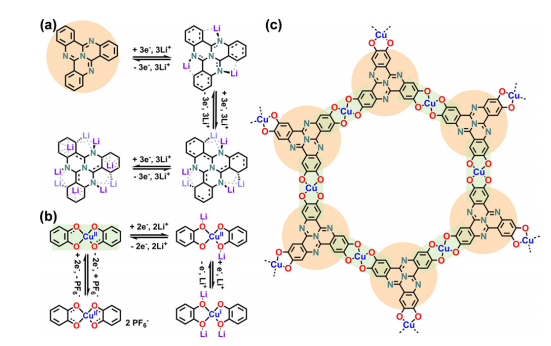
研究进展

Immobilizing Redox-Active Tricycloquinazoline into a 2D Conductive Metal–Organic Framework for Lit...

2022-03-28

53
Jie Yan, Yutao Cui, Mo Xie, Guo-Zhan Yang, De-Shan Bin,* and Dan Li*Abstract: Heteroaromatic-conjugated aromatic molecules have inspired numerous inte...
查看更多 >
2021-03-10
Cr2O7 2 inside Zr/Hf-based metal–organic frameworks: highly sensitive and selective detection and crystallographic evidence


72次浏览
Kun Wu, Ji Zheng, Yong-Liang Huang, Dong Luo, Yan Yan Li, Weigang Lu * and Dan Li *Abstract:Herein, we report the synthesis of three pairs of isostructural zirconium- and hafnium-based homometallic metal–organic frameworks (MOFs, termed Zr-MOF-1 and Hf-MOF-1, Zr-MOF-2 and Hf-MOF-2, and Zr-MOF-3 and Hf-MOF-3) with respective scu, sqc, and flu topologies by using the aggregation-induced-emission (AIE) ligand H4BTTB (4,4′,4′′,4′′′-(pyrazine-2,3,5,6-tetrayl)tetrabenzoic acid). As expected, all of th
>
2021-03-10
Lanthanide-functionalized metal–organic frameworks as ratiometric luminescent sensors


48次浏览
Yifang Zhao and Dan Li *Abstract:Metal–orgainc frameworks (MOFs) are a class of hybrid inorganic/organic framework materials and have been widely used in smart sensing. Among them, MOF-based monochromatic luminescent sensors display a limited detecting accuracy due to their easily disturbed signal. Combining the merits of lanthanide (Ln) luminescence with a porous skeleton, Ln-functionalized dual/multiple-emitting metal–organic frameworks (MOFs) have exhibited potential applications in ratiometr
>
2021-03-10
Guest effects on crystal structure and phosphorescence of a Cu6L3 prismatic cage


47次浏览
Zhi-Chun Shi, Wei Chen, Shun-Ze Zhan, Mian Li, Mo Xie, Yan Yan Li, Seik Weng Ng, Yong-Liang Huang, Zhiyin Zhang, Guo-Hong Ning * and Dan Li *Abstract:Coordination cages with a nanocavity can encapsulate various guests, which allows modulation of the physical and chemical properties of the host–guest inclusion complexes. In this work, we designed and prepared a phosphorescence Cu6L3 trigonal prismatic cage, which accommodates a series of aromatic guest molecules. Single crystal X-ray analysis rev
>
2021-03-09
Optimizing supramolecular interactions in metal– organic frameworks for C2 separation


44次浏览
Gui-Fang Hua, Xiao-Jing Xie, Weigang Lu * and Dan Li *Abstract:C2 separation is of great importance in the petrochemical industry. Traditionally, it is performed by distillation at cryogenic temperatures, which necessitates the consumption of a huge amount of energy to operate the refrigeration system in the production process. In this regard, it is imperative to seek alternative separation methods with high efficiency and low energy cost. Although of recent origin, metal–organic frameworks (MOF
>
2021-03-09
Self-assembly of mixed-valence and heterometallic metallocycles: efficient catalysts for the oxidation of alcohols to aldehydes in ambient air


42次浏览
Ya-Liang Lai, Xue-Zhi Wang, Rui-Rong Dai, Yong-Liang Huang, Xian-Chao Zhou,Xiao-Ping Zhou * and Dan LiAbstract:Two mixed-valence CuII/CuI and two heterometallic CuII/AgI metallocycles have been synthesized by the assembly of designed metalloligands and CuI/AgI ions, respectively. The CuII/CuI metallocycle can catalyze the oxidation of alcohols to aldehydes mediated by a co-catalyst, TEMPO (2,2,6,6-tetramethylpiperdine-1-oxyl), with ambient air as an oxidant, while the CuII/AgI metallocycle has n
>
2021-03-09
Coinage-Metal-Based Cyclic Trinuclear Complexes with Metal−Metal Interactions: Theories to Experiments and Structures to Functions


61次浏览
Ji Zheng, Zhou Lu, Kun Wu, Guo-Hong Ning,* and Dan Li*ABSTRACT: Among the d10 coinage metal complexes, cyclic trinuclear complexes (CTCs) or trinuclear metallocycles with intratrimer metal−metal interactions are fascinating and important metal−organic or organometallic π-acids/bases. Each CTC of characteristic planar or near-planar trimetal nine-membered rings consists of Au(I)/Ag(I)/Cu(I) cations that linearly coordinate with N and/or C atoms in ditopic anionic bridging ligands. Since the first
>




